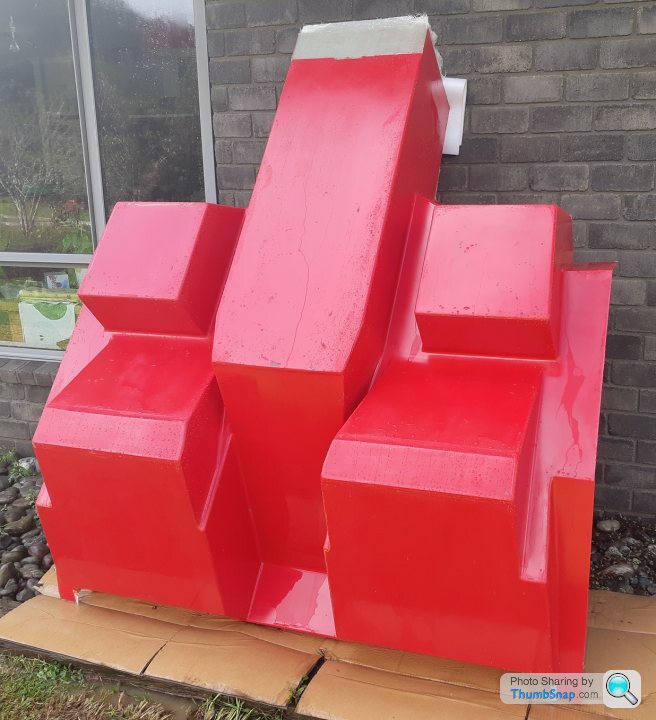540HP NA 7L V12 3 seater
Discussion
F1natic said:
Thank you all for the input, appreciate other eyes on the design. Thanks Skwdenyer for posting the close up and notes, the casting is bolted to the chassis tubes in 4 positions (at the ends near nodes with multiple tubes and 2 at the "shock tower"). The shock loads go directly into the chassis plate and backing tube so the casting is almost continuously a "spacer" under compression. The outer dogbone towers carry the majority of the upperwishbone loads to the casting mounting bolts at either end (The 2 bosses are visible in the underside photo). The towers locate the dogbones and are on a plate that has flanges both sides so that overall flex is decreased.
Perhaps I should have stated the part was cast in carbon steel BS 3100 A4, 320Mpa minimum yield, which has good strength and ductility. For the purposes of entertainment (the whole point of this build log) and review I will explain the loads and review a couple of good examples from recent high end sports cars later, however right now my focus this Waitangi long weekend is getting the interior bulkhead mould finished and off the plug.
I assumed it was aluminium! Steel should be up to the job, it does look a lot like aluminium in the picPerhaps I should have stated the part was cast in carbon steel BS 3100 A4, 320Mpa minimum yield, which has good strength and ductility. For the purposes of entertainment (the whole point of this build log) and review I will explain the loads and review a couple of good examples from recent high end sports cars later, however right now my focus this Waitangi long weekend is getting the interior bulkhead mould finished and off the plug.
Edited by F1natic on Friday 3rd February 20:11
I thought the detail pics here may help out with the project, if you search the seller on that site they have lots of used F1 parts, dread to think what they would want for it though!
https://www.racecarsdirect.com/Advert/Details/1325...
https://www.racecarsdirect.com/Advert/Details/1325...
Have the full set of shock mount castings made, bit of surface clean up then off for normalising heat treatment. Some simple machining then the parts will then be ready to weld to chassis tubing.
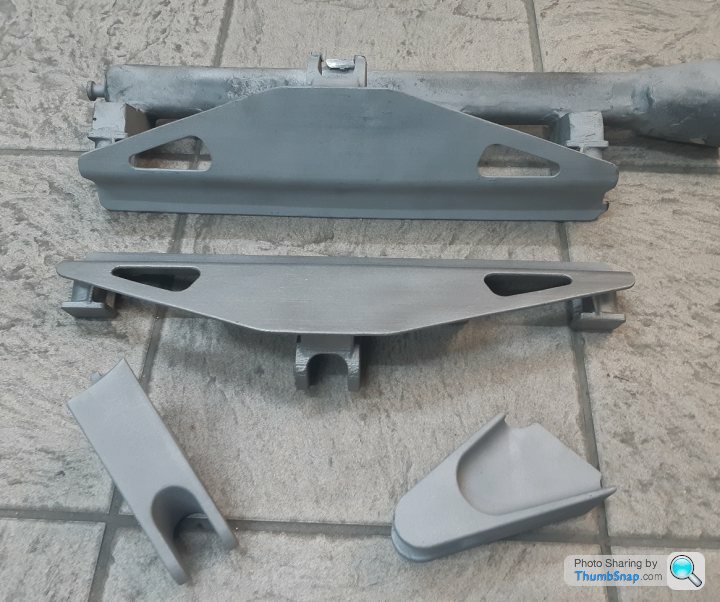
A bit of rear subframe detail showing the handed rear shock mount castings in situ. I like triangulation.
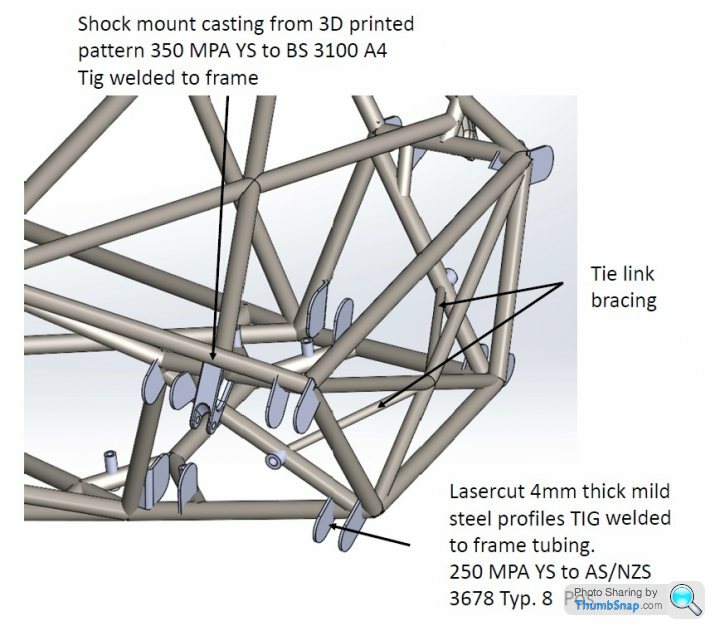

A bit of rear subframe detail showing the handed rear shock mount castings in situ. I like triangulation.

Edited by F1natic on Tuesday 7th March 06:50
Thanks for the positive encouragement, it's either going to be an epic win or an epic fail, but I am having fun building it regardless!
Windscreen search has progressed sideways - measured up a potential option from an NA2 Honda NSX as it looked like a contender with modification, however proved to be 150mm too short. Have watched just about every movie of an F1 that is near overhead lighting or a straight edge in an attempt to "ray trace" the curvature and it definitely has a compound curve at the upper edge that blends into the roof - it's quite the unique shape.
Once the interior bulkhead is mounted to the build table the gear box will be positioned temporarily and shifter operation tested. In preparation for that event have made a couple of small parts for the shift reverser (3D printed patterns cast in 316 stainless - detailed in this thread back in June 2021!!).
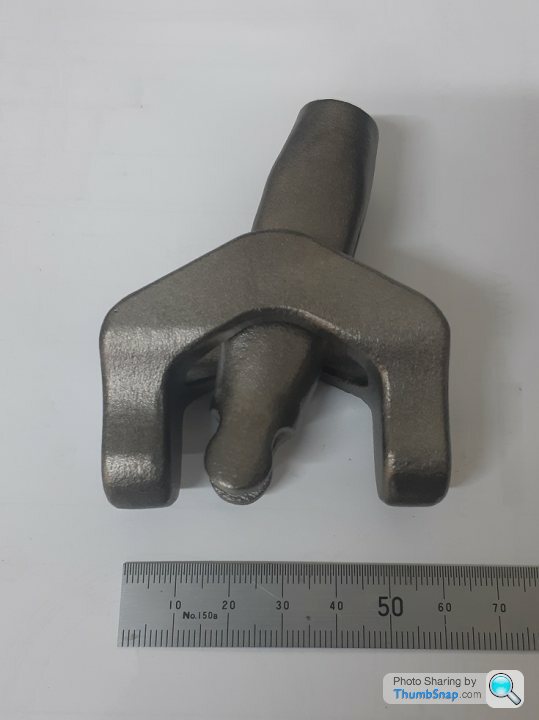
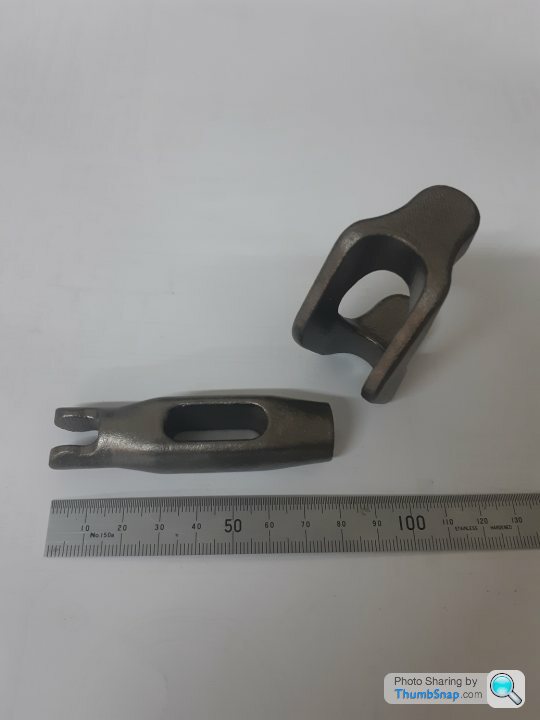
Windscreen search has progressed sideways - measured up a potential option from an NA2 Honda NSX as it looked like a contender with modification, however proved to be 150mm too short. Have watched just about every movie of an F1 that is near overhead lighting or a straight edge in an attempt to "ray trace" the curvature and it definitely has a compound curve at the upper edge that blends into the roof - it's quite the unique shape.
Once the interior bulkhead is mounted to the build table the gear box will be positioned temporarily and shifter operation tested. In preparation for that event have made a couple of small parts for the shift reverser (3D printed patterns cast in 316 stainless - detailed in this thread back in June 2021!!).


Thought this may be of interest given the layout, looks like two v8 engines mated in the middle.
https://www.youtube.com/watch?v=y1gH0V4AOCo&ab...
https://www.youtube.com/watch?v=y1gH0V4AOCo&ab...
Thanks Paul, the Cizeta has always inspired me.
Not much visible progress on the build table, but all the shock mounts are back from heat treating and ready for machining when I get the next opportunity.
Have been adding detail to the door CAD model which had only been roughed out for the build approval stage. Tasks like ensuring the hinges and gas strut mechanisms all work as required and clear the A pillar and windscreen, as shown below. The front hinge mount and door latch incorporate lots of adjustment so that the door skin can be spaced and bolted into a position on the anti-intrusion bar that gives the best door gaps when closed. Hinges will be 3D printed and cast in steel. The hinge pin emergency release mechanism still needs fleshing out, then mocking up.
The interior plug was a little damaged during mould removal, but is now serving duty as the base for the cabin mockup. Dashboard, windscreen surround mockup, door mockups and interior roof parts will be fitted to this initially while the driveable chassis is being assembled on the build table.
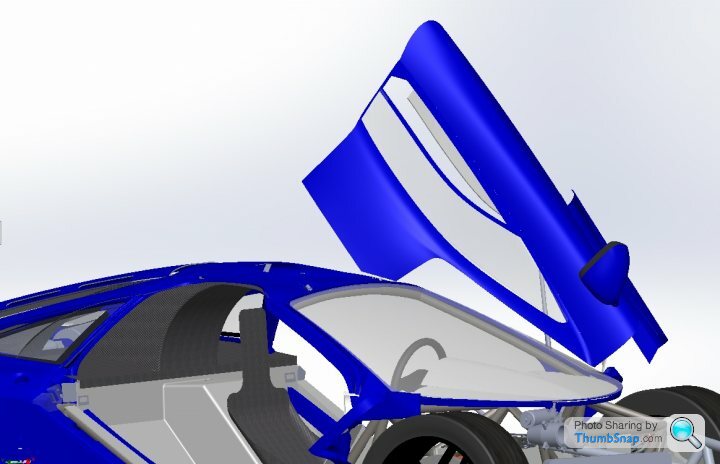
Not much visible progress on the build table, but all the shock mounts are back from heat treating and ready for machining when I get the next opportunity.
Have been adding detail to the door CAD model which had only been roughed out for the build approval stage. Tasks like ensuring the hinges and gas strut mechanisms all work as required and clear the A pillar and windscreen, as shown below. The front hinge mount and door latch incorporate lots of adjustment so that the door skin can be spaced and bolted into a position on the anti-intrusion bar that gives the best door gaps when closed. Hinges will be 3D printed and cast in steel. The hinge pin emergency release mechanism still needs fleshing out, then mocking up.
The interior plug was a little damaged during mould removal, but is now serving duty as the base for the cabin mockup. Dashboard, windscreen surround mockup, door mockups and interior roof parts will be fitted to this initially while the driveable chassis is being assembled on the build table.

For those readers interested here is the explanation of the loading calcs for the front upper control arm bracket, using loading factors based on the ULSAS project Lotus had involvement with – i.e. an actual trustworthy internet source!
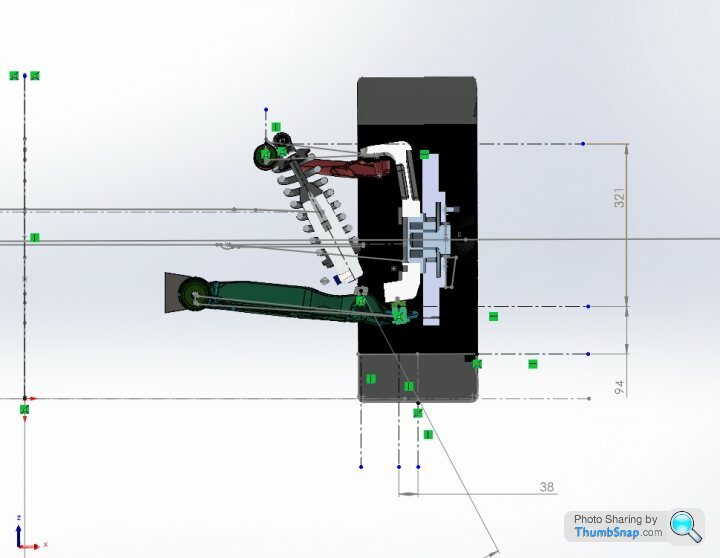
At static 1g vertical loading (assumed at the centre of the contact patch) the front corner weight in gross vehicle mass condition is 337kg or 3305N vertical. For equilibrium around the bottom ball joint the moment caused by the contact patch offset has to equal the moment caused by the upper wishbone horizontal load.
In this case the horizontal loads at 1g static are (3305N x 0.038m)/0.321m = 391N compressive or around 40kg “pushing into” the casting spread equally over the four towers.
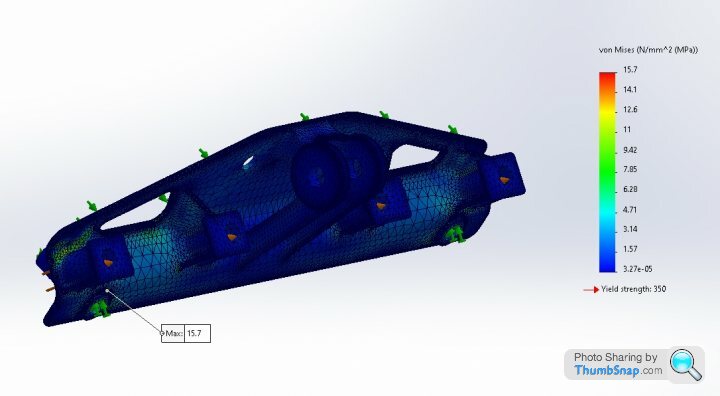
For a kerb strike the load (see table below) also includes an additional 1.5g force at the rim height which results in a tensile horizontal force of 1060N or approximately 27kg “hanging” from each of the four towers. This results in a maximum stress of about 16 MPa. Yield is 350 MPa so a large safety factor.
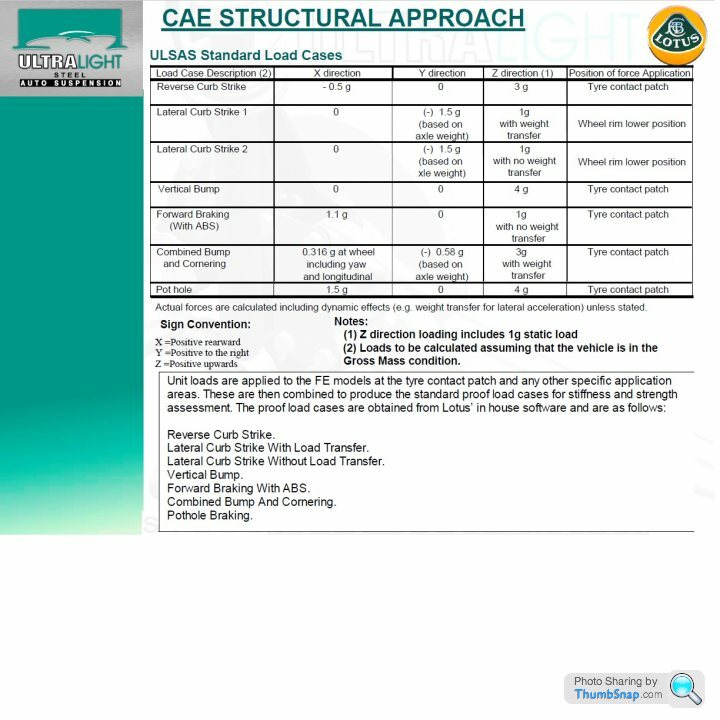

At static 1g vertical loading (assumed at the centre of the contact patch) the front corner weight in gross vehicle mass condition is 337kg or 3305N vertical. For equilibrium around the bottom ball joint the moment caused by the contact patch offset has to equal the moment caused by the upper wishbone horizontal load.
In this case the horizontal loads at 1g static are (3305N x 0.038m)/0.321m = 391N compressive or around 40kg “pushing into” the casting spread equally over the four towers.

For a kerb strike the load (see table below) also includes an additional 1.5g force at the rim height which results in a tensile horizontal force of 1060N or approximately 27kg “hanging” from each of the four towers. This results in a maximum stress of about 16 MPa. Yield is 350 MPa so a large safety factor.

Hi Voldo, best way to describe is to refer to a few old images
There is a fairly sizeable gap between the opposing motors that the Tbox sits in. For my first pass through the design there is a very stout casting or "pumpkin", very similar to a diff head, which has large outer flanges that directly bolt to the bellhousings, which then mount and align the motors. The dual mass flywheels of the first iteration reside inside these custom bellhousings, however I have not gotten my hands on a genuine clutch assembly yet so final sizing and prototypes have not been made. I was hoping to have by now but life.
Early in the project I scoured the internet trying to find a diff that was 1:1 ratio, only thing close was a Haldex unit from a VW Golf R32, however would never have survived the torque output of the 2 V6's. I did contemplate doing a low buck grass kart of the concept using a couple of small 4 cyl engines and the VW unit, however felt it was better to build it once and prove it full scale.
The custom made pinions are subjected to quite high side and thrust forces as they are only loaded on one side, the custom made crownwheel has much less deflection due to "equal" loading on opposite sides, however it has twice the thrust to cope with. The crownwheel and pinions are all mounted in large widely spaced bearings in the pumpkin, so self-contained. The transaxle input shaft slides into an appropriately splined hole in the crownwheel, and the pinion input splines slide into the clutches. To achieve a reasonable life I was guided by the Cosworth work on the Valkyrie engine, where they designed for 250 hrs at full load. The pumpkin also has an inspection hatch so I can examine the gear set in situ during development driving, and of course the whole powerplant drops out for easy "remedial" work, which we all know will need to be done.
Did consider straight bevel gears but the life is shorter and noise too high, cabin is going to be noisy enough already.
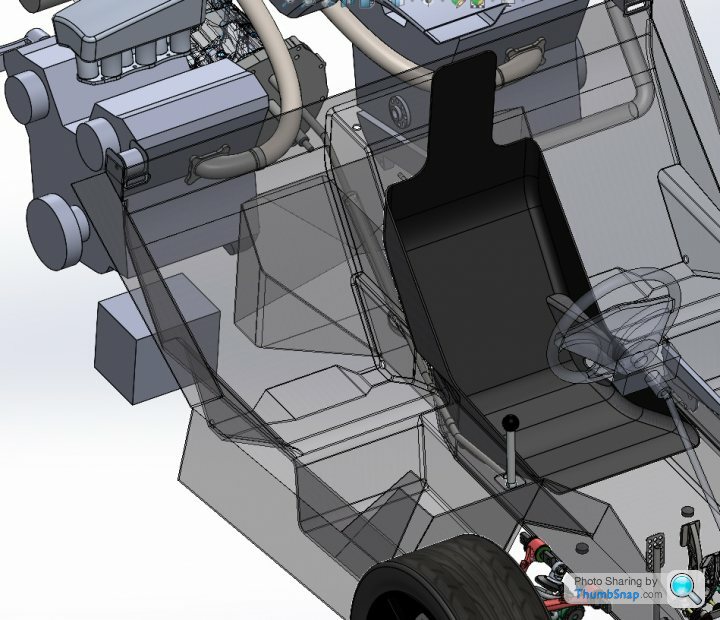
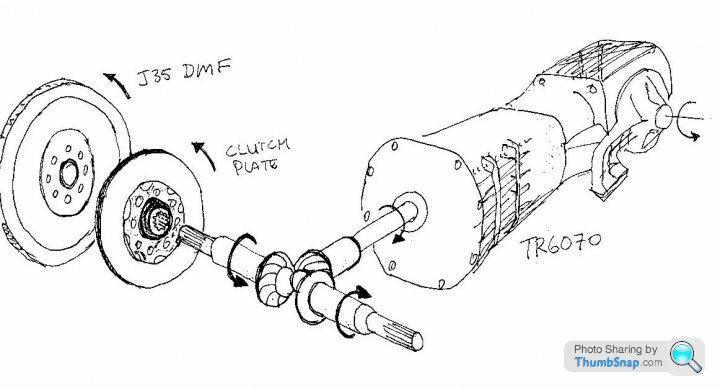
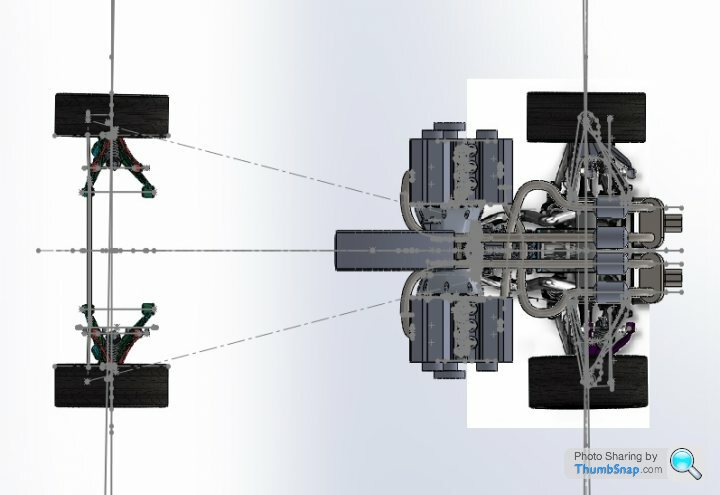
Just found out yesterday about the Daimler Benz efforts in WW2, I think the google algorithm is getting slack.
https://oldmachinepress.com/2021/07/20/daimler-ben...

There is a fairly sizeable gap between the opposing motors that the Tbox sits in. For my first pass through the design there is a very stout casting or "pumpkin", very similar to a diff head, which has large outer flanges that directly bolt to the bellhousings, which then mount and align the motors. The dual mass flywheels of the first iteration reside inside these custom bellhousings, however I have not gotten my hands on a genuine clutch assembly yet so final sizing and prototypes have not been made. I was hoping to have by now but life.
Early in the project I scoured the internet trying to find a diff that was 1:1 ratio, only thing close was a Haldex unit from a VW Golf R32, however would never have survived the torque output of the 2 V6's. I did contemplate doing a low buck grass kart of the concept using a couple of small 4 cyl engines and the VW unit, however felt it was better to build it once and prove it full scale.
The custom made pinions are subjected to quite high side and thrust forces as they are only loaded on one side, the custom made crownwheel has much less deflection due to "equal" loading on opposite sides, however it has twice the thrust to cope with. The crownwheel and pinions are all mounted in large widely spaced bearings in the pumpkin, so self-contained. The transaxle input shaft slides into an appropriately splined hole in the crownwheel, and the pinion input splines slide into the clutches. To achieve a reasonable life I was guided by the Cosworth work on the Valkyrie engine, where they designed for 250 hrs at full load. The pumpkin also has an inspection hatch so I can examine the gear set in situ during development driving, and of course the whole powerplant drops out for easy "remedial" work, which we all know will need to be done.
Did consider straight bevel gears but the life is shorter and noise too high, cabin is going to be noisy enough already.



Just found out yesterday about the Daimler Benz efforts in WW2, I think the google algorithm is getting slack.
https://oldmachinepress.com/2021/07/20/daimler-ben...

Edited by F1natic on Wednesday 26th April 09:47
F1natic said:
The custom made pinions are subjected to quite high side and thrust forces as they are only loaded on one side, the custom made crownwheel has much less deflection due to "equal" loading on opposite sides, however it has twice the thrust to cope with. The crownwheel and pinions are all mounted in large widely spaced bearings in the pumpkin, so self-contained. The transaxle input shaft slides into an appropriately splined hole in the crownwheel, and the pinion input splines slide into the clutches. To achieve a reasonable life I was guided by the Cosworth work on the Valkyrie engine, where they designed for 250 hrs at full load. The pumpkin also has an inspection hatch so I can examine the gear set in situ during development driving, and of course the whole powerplant drops out for easy "remedial" work, which we all know will need to be done.
If the side forces are too high on the input shaft pinions, you could fit a second, "idler" crownwheel (akin to the gears in a normal diff). In fact, you could fit three of them  You'd probably need some way to adjust for lash and preload on all of them, of course, but it would resolve potential periodic (fatigue) problems with the input shaft pinions, and of course just make the whole thing a bit more balanced.
You'd probably need some way to adjust for lash and preload on all of them, of course, but it would resolve potential periodic (fatigue) problems with the input shaft pinions, and of course just make the whole thing a bit more balanced.Just a thought; I don't know your load cases
 Quick mock-up here:
Quick mock-up here: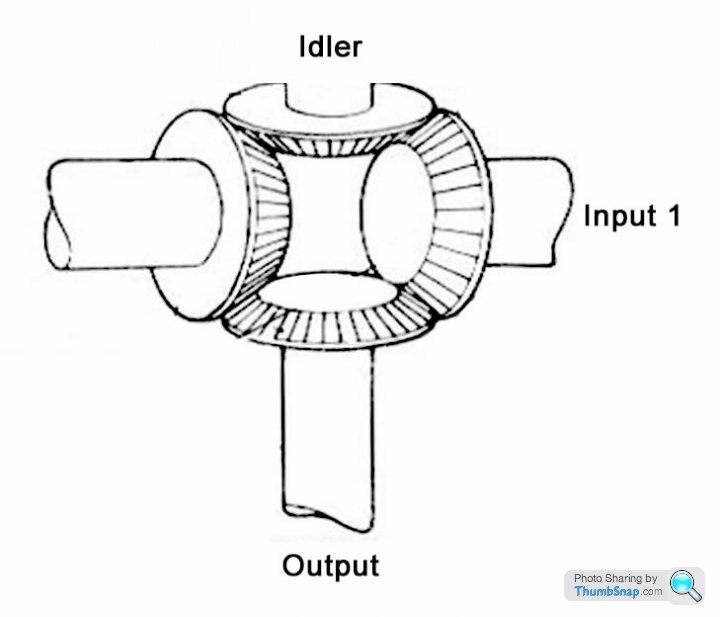
Appreciate the idea, might help if I find durability a problem with the simplest configuration. I had considered adding an ISG (integrated starter generator as per the T50) in the idler position, but since I am running belts for the dry sump and max rpm is only 7500 happy to use an off the shelf alternator and starter motor. The inspection panel is in the idler position and the crownwheel is also assembled through that aperture. Shimming the pinions and crownwheel so that tooth contact positions are correct is going to be a real exercise in patience. Trying to make the mule as low spec as practical for the first iteration so I can get the thing completed. Currently in a bit of a lull while I raise some funds for a clutch (which is a keystone for finishing the tbox design) and some tubing for the space frame. Should probably focus on starting the test engine in the downtime 
Have also come up with a workaround for the thing that bugs me most about the genuine F1, the headlight eyebrow panels. I have sourced a Mercedes SLK vario roof hydraulic motor to actuate the rear spoiler, so a couple of extra lines to power some actuators on the eyebrow panels will emulate the Nissan RCP92 front end styling, where the flaps can fully open to vent radiator air at low bumper to bumper speed, flush for low drag and cracked open slightly for an HDK effect. Will be quite smug if the idea works better than the original slot design of the clinic model.
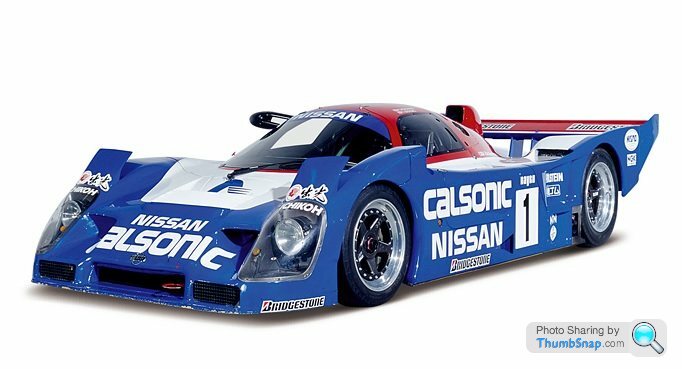
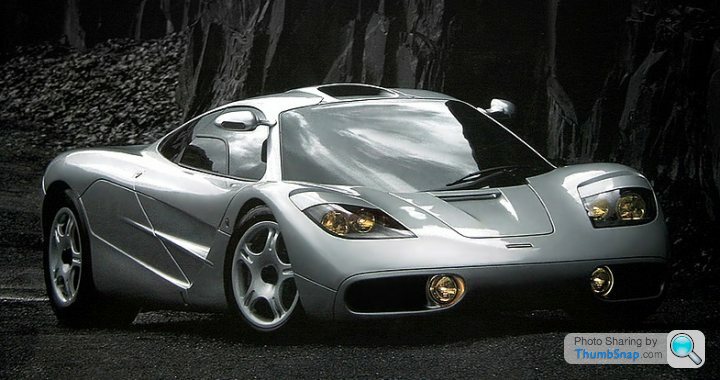

Have also come up with a workaround for the thing that bugs me most about the genuine F1, the headlight eyebrow panels. I have sourced a Mercedes SLK vario roof hydraulic motor to actuate the rear spoiler, so a couple of extra lines to power some actuators on the eyebrow panels will emulate the Nissan RCP92 front end styling, where the flaps can fully open to vent radiator air at low bumper to bumper speed, flush for low drag and cracked open slightly for an HDK effect. Will be quite smug if the idea works better than the original slot design of the clinic model.


Edited by F1natic on Saturday 29th April 05:03
F1natic said:
PAUL500 said:
Front screen is the only thing left to sort, Pilkington here in the UK will make one offs from a mould or will cut down an existing screen if it has a similar shape, so still researching that area.
Impressive specification Paul, what do you think the torque limit for the 355 box is?I have actually pretty much given up on the idea of finding a suitable screen - the Artiplastzabrze attempt used the cutting and disguising with banding, but it looks a little "off" to my eye. Therefore have been conducting experiments in a small muffle furnace at 650C with stacked 1.75mm pieces of glass and they have formed to the contour of the stainless steel mould quite well. Have formed up to 6mm thick, but need to eliminate some small surface pock marks, currently using talc as the release agent so going to try boron nitride next. Once the pocking is resolved I will be moving to larger scale tests and then need to find someone with an autoclave to do the PVB lamination tests (145C at 10 bar).

Also have CNC cut a 1/10 scale female mould in polystyrene foam and cast a plaster of paris plug, the contours feel nice.
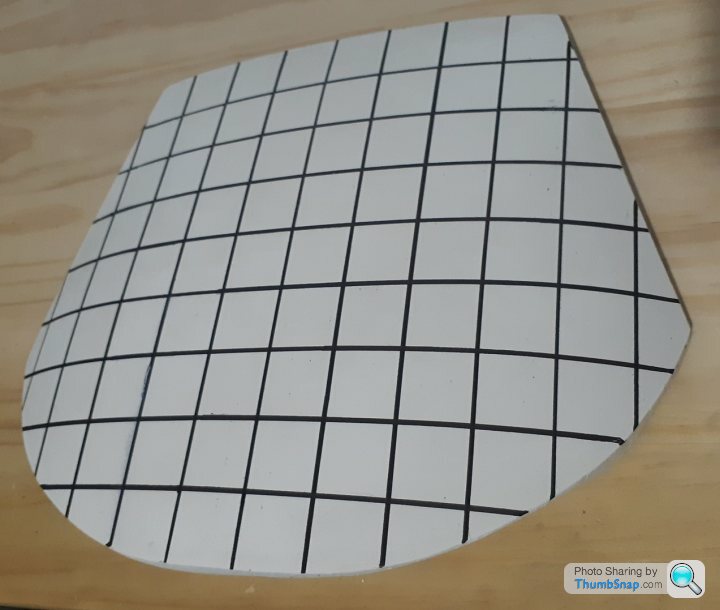
New Zealand, much like the rest of the world, has gone into lock down. Over the next 4 weeks, if I stay healthy, plan to bang out the interior detail. Fortunate that I can work from home and thus have brought a 3D printer home. The distraction from the outside world events will be welcome.
Good luck to everyone, it is a s
 tty hand we have been dealt, hope you can make the most of it.
tty hand we have been dealt, hope you can make the most of it.Edited by F1natic on Tuesday 24th March 10:50
I have access to one if you want to check any measurements, I realise it does not help in finding a suitable glass screen but could help as a mock up if close enough, and a guy in NZ made a faux F40 so may have the mould for the rear screen still.
Alternatively it does look like the front screen for the new Lotus Emira is similar to the F1 version,
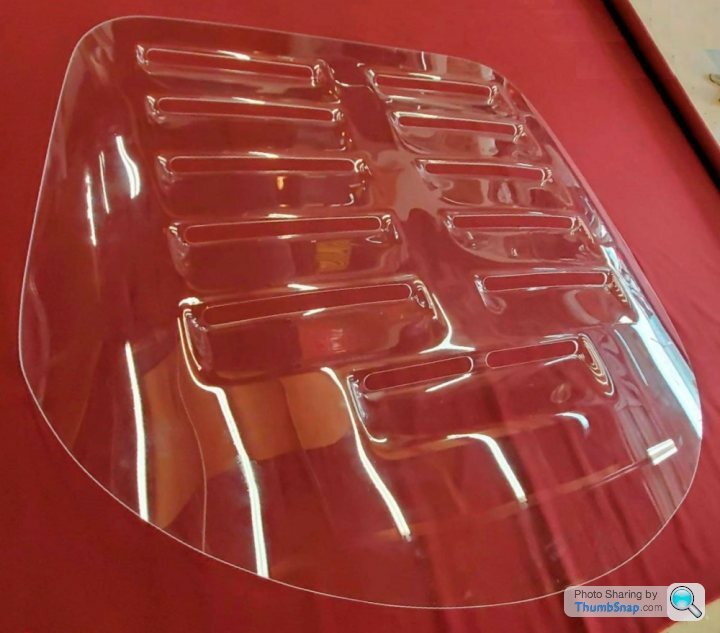
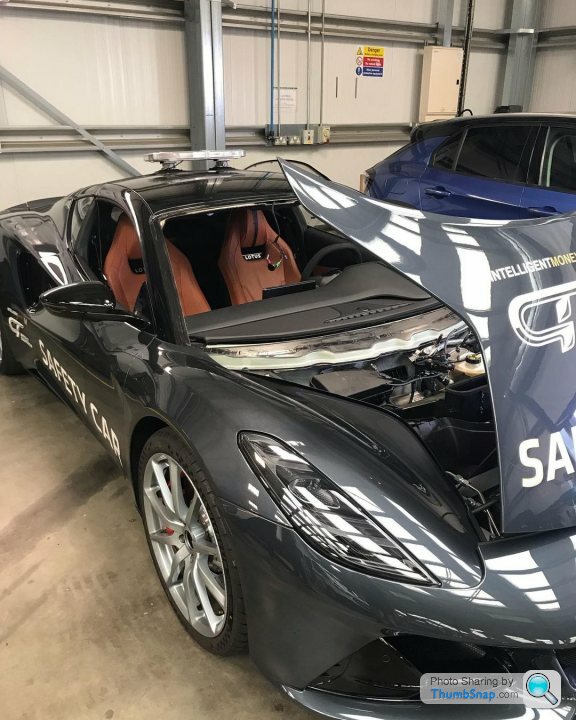
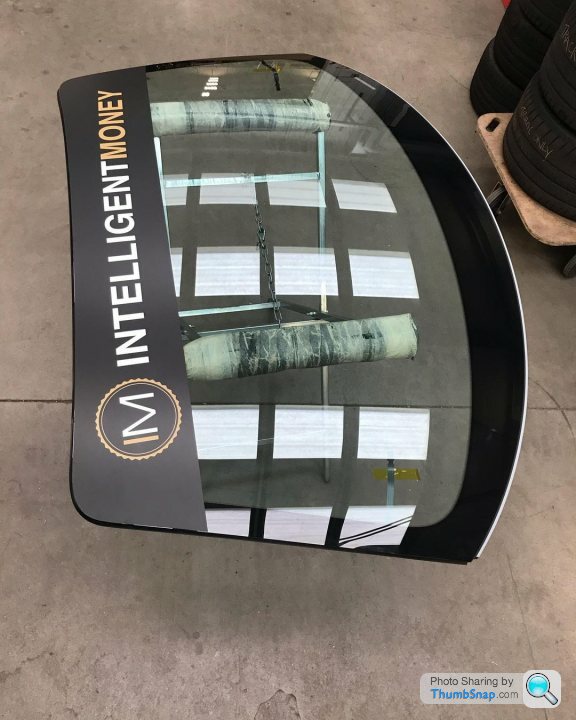
Good spotting Paul! I will ask the F40 Development guys if they have an old engine cover available for measuring, they are just down the road from me and quite supportive, even if it's just to discuss how they went about making theirs.
The Emira is an unexplored option, thanks to you I will look into it!
The Emira is an unexplored option, thanks to you I will look into it!
Bit of a detour, bought an old Singer 591 industrial sewing machine for $90, and a heavy duty conversion kit (bigger feed dogs, larger needles and speed reduction)

The roller presser foot is the most helpful upgrade, it allows multiple layers of leather to feed though. Still accelerates way to fast with my inexperienced hoof, but was considerably cheaper than the proper walking foot variety that are recommended for heavy materials. As the cabin will mostly be alcantara it should cope. Highly recommend Cechaflo youtube channel for hands on tutorials.
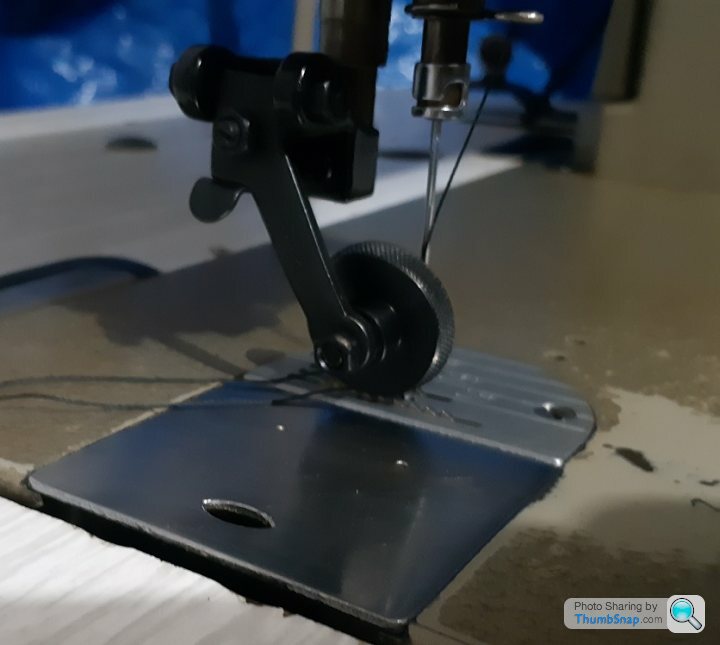
Turns out the estimate for weight of the OEM flywheel and clutch was close, a touch over 20 kgs each, which really hurts as there has to be 2 of them. Rice cracker diet has been implemented to help offset. Under-guessed the stack height with throwout bearing and have to move the engines out extra 50mm each, but luckily there are no clashes with the frame model. Confirming the OD of the ring gear enabled both engines to be dropped another 25mm without issue, which is beneficial. The transaxle is thus rotated nosedown a fraction more, don't expect any oil feed issues as the pump is at the lower front and the TR6070's are designed for high slosh use.


The roller presser foot is the most helpful upgrade, it allows multiple layers of leather to feed though. Still accelerates way to fast with my inexperienced hoof, but was considerably cheaper than the proper walking foot variety that are recommended for heavy materials. As the cabin will mostly be alcantara it should cope. Highly recommend Cechaflo youtube channel for hands on tutorials.

Turns out the estimate for weight of the OEM flywheel and clutch was close, a touch over 20 kgs each, which really hurts as there has to be 2 of them. Rice cracker diet has been implemented to help offset. Under-guessed the stack height with throwout bearing and have to move the engines out extra 50mm each, but luckily there are no clashes with the frame model. Confirming the OD of the ring gear enabled both engines to be dropped another 25mm without issue, which is beneficial. The transaxle is thus rotated nosedown a fraction more, don't expect any oil feed issues as the pump is at the lower front and the TR6070's are designed for high slosh use.

Edited by F1natic on Wednesday 17th May 11:38
F1natic said:
The roller presser foot is the most helpful upgrade, it allows multiple layers of leather to feed though. Still accelerates way to fast with my inexperienced hoof, but was considerably cheaper than the proper walking foot variety that are recommended for heavy materials. As the cabin will mostly be alcantara it should cope. Highly recommend Cechaflo youtube channel for hands on tutorials.

I remember my Father getting a hold of a very early sample of Alcantara back in the late 70s / early 80s. He was in the global textile business. It was a miracle-like material back then.
From memory, it was very sensitive to thread tension during sewing. That machine definitely looks like the way to go. You're definitely diving in with both feet

Gassing Station | Readers' Cars | Top of Page | What's New | My Stuff




